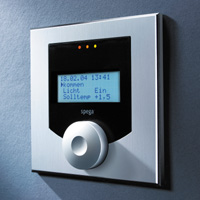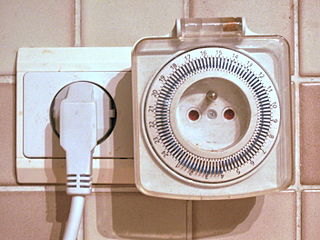Related Research Articles

Home automation or domotics is building automation for a home. A home automation system will monitor and/or control home attributes such as lighting, climate, entertainment systems, and appliances. It may also include home security such as access control and alarm systems.

A security alarm is a system designed to detect intrusions, such as unauthorized entry, into a building or other areas, such as a home or school. Security alarms protect against burglary (theft) or property damage, as well as against intruders. Examples include personal systems, neighborhood security alerts, car alarms, and prison alarms.
Building automation (BAS), also known as building management system (BMS) or building energy management system (BEMS), is the automatic centralized control of a building's HVAC, electrical, lighting, shading, access control, security systems, and other interrelated systems. Some objectives of building automation are improved occupant comfort, efficient operation of building systems, reduction in energy consumption, reduced operating and maintaining costs and increased security.

A smart meter is an electronic device that records information—such as consumption of electric energy, voltage levels, current, and power factor—and communicates the information to the consumer and electricity suppliers. Such an advanced metering infrastructure (AMI) differs from automatic meter reading (AMR) in that it enables two-way communication between the meter and the supplier.
Home automation for the elderly and disabled focuses on making it possible for older adults and people with disabilities to remain at home, safe and comfortable. Home automation is becoming a viable option for older adults and people with disabilities who would prefer to stay in the comfort of their homes rather than move to a healthcare facility. This field uses much of the same technology and equipment as home automation for security, entertainment, and energy conservation but tailors it towards old people and people with disabilities.

A smart transducer is an analog or digital transducer, actuator or sensor combined with a processing unit and a communication interface.
The Internet of things (IoT) describes devices with sensors, processing ability, software and other technologies that connect and exchange data with other devices and systems over the Internet or other communications networks. The Internet of things encompasses electronics, communication, and computer science engineering. "Internet of things" has been considered a misnomer because devices do not need to be connected to the public internet; they only need to be connected to a network and be individually addressable.

A time switch is a device that operates an electric switch controlled by a timer.

Google Nest is a line of smart home products including smart speakers, smart displays, streaming devices, thermostats, smoke detectors, routers and security systems including smart doorbells, cameras and smart locks.
Nivis, LLC is a company that designs and manufactures wireless sensor networks for smart grid and industrial process automation. Target applications include process monitoring, environmental monitoring, power management, security, and the internet of things. The company is headquartered in Atlanta, Georgia, with additional offices in Romania, where much of its technology is developed. The company's product portfolio consists of standards-based wireless communications systems, including radio nodes, routers, management software and a software stack for native communications. Nivis hardware is operated by open source software.

"Fourth Industrial Revolution", "4IR", or "Industry 4.0" is a buzzword and neologism describing rapid technological advancement in the 21st century. The term was popularised in 2016 by Klaus Schwab, the World Economic Forum founder and executive chairman, who says that the changes show a significant shift in industrial capitalism.

HomeKit, also known as Apple Home, is a software framework and communication protocol developed by Apple Inc. that lets users configure, communicate with and control smart-home appliances using Apple devices. It provides users with a way to automatically discover such devices and configure them. By designing rooms, items and actions in HomeKit, users can enable automations in the home through a voice command to Siri or through the Home app. With HomeKit, developers are able to create complex applications in order to manage accessories at a high level.
Endpoint security or endpoint protection is an approach to the protection of computer networks that are remotely bridged to client devices. The connection of endpoint devices such as laptops, tablets, mobile phones, Internet-of-things devices, and other wireless devices to corporate networks creates attack paths for security threats. Endpoint security attempts to ensure that such devices follow a definite level of compliance to standards.
Operational technology (OT) is hardware and software that detects or causes a change, through the direct monitoring and/or control of industrial equipment, assets, processes and events. The term has become established to demonstrate the technological and functional differences between traditional information technology (IT) systems and industrial control systems environment, the so-called "IT in the non-carpeted areas".
Myfox is a privately held French company that designs and produces connected, sensor-driven and wireless home security equipment.
Hive is a trademark owned by Centrica Hive Limited that produces smart home devices. It is one of the largest connected home providers in the UK and, as of May 2018, the company had more than 1,000,000 customers.
The industrial internet of things (IIoT) refers to interconnected sensors, instruments, and other devices networked together with computers' industrial applications, including manufacturing and energy management. This connectivity allows for data collection, exchange, and analysis, potentially facilitating improvements in productivity and efficiency as well as other economic benefits. The IIoT is an evolution of a distributed control system (DCS) that allows for a higher degree of automation by using cloud computing to refine and optimize the process controls.
The Internet of Military Things (IoMT) is a class of Internet of things for combat operations and warfare. It is a complex network of interconnected entities, or "things", in the military domain that continually communicate with each other to coordinate, learn, and interact with the physical environment to accomplish a broad range of activities in a more efficient and informed manner. The concept of IoMT is largely driven by the idea that future military battles will be dominated by machine intelligence and cyber warfare and will likely take place in urban environments. By creating a miniature ecosystem of smart technology capable of distilling sensory information and autonomously governing multiple tasks at once, the IoMT is conceptually designed to offload much of the physical and mental burden that warfighters encounter in a combat setting.

Home Assistant is free and open-source software for home automation designed to be an Internet of things (IoT) ecosystem-independent integration platform and central control system for smart home devices, with a focus on local control and privacy. It can be accessed through a web-based user interface, by using companion apps for Android and iOS, or by voice commands via a supported virtual assistant, such as Google Assistant or Amazon Alexa, and their own "Assist".

Develco Products is a B2B wireless technology producer, headquartered in Aarhus, Denmark. The company was established in 2007 and develops white label devices for B2C solution providers and has over 3,500,000 devices deployed worldwide... Their main business areas are home care, security, and smart energy. They are a member of the Connectivity Standards Alliance as their main technological expertise lies in Zigbee-based devices that communicate through a mesh network. The company claims their most popular product is the Squid.link gateway.
References
- ↑ Pal, Souvik; Diaz, Vicente Garcia; Le, Dac-Nhuong (2022). IoT: Security and Privacy Paradigm (Internet of Everything (IoE)) (1st ed.). CRC Press. ISBN 978-1032239644.
- ↑ Martin, Trevor (2022). Designing Secure IoT Devices with the Arm Platform Security Architecture and Cortex-M33. Newnes. ISBN 9780128214695.
- ↑ Shandilya, Shishir K.; Chun, Soon Ae; Shandilya, Smita; Weippl, Edgar (2018). Internet of Things Security: Fundamentals, Techniques and Applications. River Publishers Series in Information Science and Technology. ISBN 9788793609532.
- ↑ Sharma, Sudhir Kumar; Bhushan, Bharat; Debnath, Narayan C. (2020). Security and Privacy Issues in IoT Devices and Sensor Networks (1st ed.). Academic Press. ISBN 978-0128212554.
- ↑ Sharma, Sudhir Kumar; Bhushan, Bharat; Debnath, Narayan C. (2022). IoT Security Paradigms and Applications. CRC Press. ISBN 9780367515003.